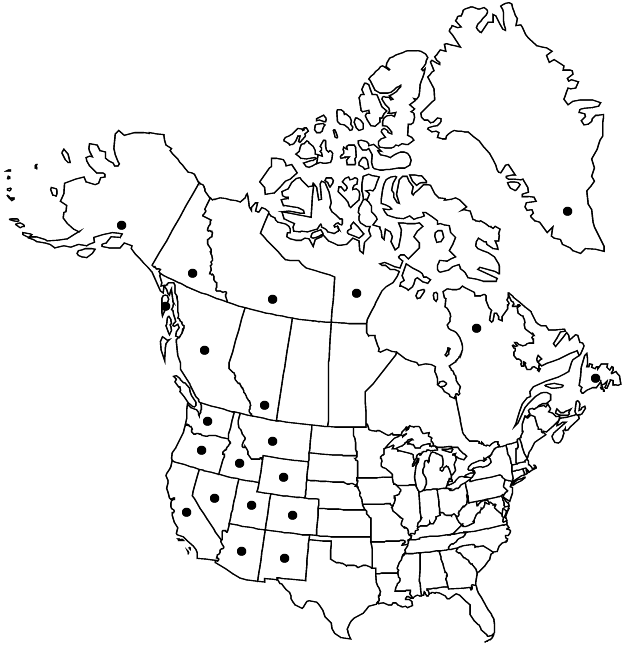Difference between revisions of "Sagina saginoides"
Deut. Fl., 539. 1882.
FNA>Volume Importer |
FNA>Volume Importer |
||
| Line 11: | Line 11: | ||
|name=Spergula saginoides | |name=Spergula saginoides | ||
|authority=Linnaeus | |authority=Linnaeus | ||
| + | |rank=species | ||
|publication_title=Sp. Pl. | |publication_title=Sp. Pl. | ||
|publication_place=1: 441. 1753 | |publication_place=1: 441. 1753 | ||
| Line 17: | Line 18: | ||
|name=Sagina linnaei | |name=Sagina linnaei | ||
|authority=C. Presl | |authority=C. Presl | ||
| + | |rank=species | ||
}} {{Treatment/ID/Synonym | }} {{Treatment/ID/Synonym | ||
|name=Sagina micrantha | |name=Sagina micrantha | ||
|authority=(Bunge) Fernald | |authority=(Bunge) Fernald | ||
| + | |rank=species | ||
}} {{Treatment/ID/Synonym | }} {{Treatment/ID/Synonym | ||
|name=Sagina saginoides var. hesperia | |name=Sagina saginoides var. hesperia | ||
|authority=Fernald | |authority=Fernald | ||
| + | |rank=variety | ||
}} | }} | ||
|hierarchy=Caryophyllaceae;Caryophyllaceae subfam. Alsinoideae;Sagina;Sagina saginoides | |hierarchy=Caryophyllaceae;Caryophyllaceae subfam. Alsinoideae;Sagina;Sagina saginoides | ||
| Line 47: | Line 51: | ||
-->{{#Taxon: | -->{{#Taxon: | ||
name=Sagina saginoides | name=Sagina saginoides | ||
| − | |||
|authority=(Linnaeus) H. Karsten | |authority=(Linnaeus) H. Karsten | ||
|rank=species | |rank=species | ||
| Line 62: | Line 65: | ||
|publication year=1882 | |publication year=1882 | ||
|special status= | |special status= | ||
| − | |source xml=https://jpend@bitbucket.org/aafc-mbb/fna-data-curation.git/src/ | + | |source xml=https://jpend@bitbucket.org/aafc-mbb/fna-data-curation.git/src/f50eec43f223ca0e34566be0b046453a0960e173/coarse_grained_fna_xml/V5/V5_291.xml |
|subfamily=Caryophyllaceae subfam. Alsinoideae | |subfamily=Caryophyllaceae subfam. Alsinoideae | ||
|genus=Sagina | |genus=Sagina | ||
Revision as of 21:52, 16 December 2019
Plants perennial, tufted or becoming cespitose in alpine habitats, glabrous. Stems ascending or sometimes procumbent, few- to many-branched, not filiform. Leaves: axillary fascicles absent; basal frequently in primary and secondary rosettes 9–45 mm diam., blade linear, 10–20 mm, not succulent, apex apiculate, rarely aristate, glabrous; cauline not conspicuously connate basally, rarely forming inflated cup in cespitose, alpine plants, blade linear, sometimes linear-subulate in cespitose plants, 4–20(–25) mm, not fleshy, apex apiculate, glabrous. Pedicels frequently recurved during capsular development, erect in fruit, filiform, glabrous. Flowers axillary or terminal, 5-merous, very rarely some 4-merous; calyx base glabrous; sepals elliptic, 2–2.5 mm, hyaline margins white, rarely purple in alpine specimens, apex obtuse to rounded, remaining appressed following capsule dehiscence; petals elliptic, (1–)1.5–2 mm, shorter than or equaling sepals; stamens (5 or) 10. Capsules 2.5–3(–3.5) mm, 1.5–2 times sepals, dehiscing to base. Seeds brown, obliquely triangular with distinct abaxial groove, 0.3–0.4 mm, smooth to slightly pebbled. 2n = 22.
Phenology: Flowering mid-late summer.
Habitat: Montane sites, open or light shade, wet places on lake margins, along stream gravels and seepages in rock ledges and roadcuts, subalpine and alpine zones
Elevation: 1000-4000 m
Distribution

Greenland, Alta., B.C., Nfld. and Labr. (Nfld.), N.W.T., Nunavut, Que., Yukon, Alaska, Ariz., Calif., Colo., Idaho, Mont., Nev., N.Mex., Oreg., Utah, Wash., Wyo., Mexico, Eurasia.
Discussion
Some specimens from alpine habitats in Montana and Alberta are intermediate between Sagina saginoides and the typically arctic S. nivalis.
Selected References
None.